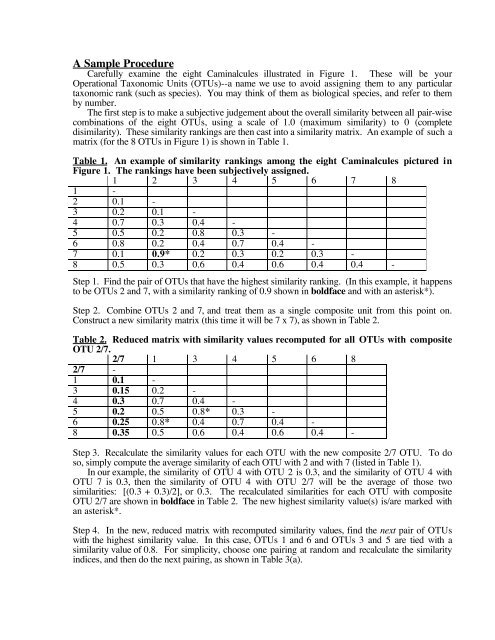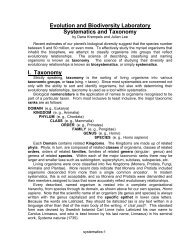Workshop: Biosystematics
Workshop: Biosystematics
Workshop: Biosystematics
You also want an ePaper? Increase the reach of your titles
YUMPU automatically turns print PDFs into web optimized ePapers that Google loves.
A Sample Procedure<br />
Carefully examine the eight Caminalcules illustrated in Figure 1. These will be your<br />
Operational Taxonomic Units (OTUs)--a name we use to avoid assigning them to any particular<br />
taxonomic rank (such as species). You may think of them as biological species, and refer to them<br />
by number.<br />
The first step is to make a subjective judgement about the overall similarity between all pair-wise<br />
combinations of the eight OTUs, using a scale of 1.0 (maximum similarity) to 0 (complete<br />
disimilarity). These similarity rankings are then cast into a similarity matrix. An example of such a<br />
matrix (for the 8 OTUs in Figure 1) is shown in Table 1.<br />
Table 1. An example of similarity rankings among the eight Caminalcules pictured in<br />
Figure 1. The rankings have been subjectively assigned.<br />
1 2 3 4 5 6 7 8<br />
1 -<br />
2 0.1 -<br />
3 0.2 0.1 -<br />
4 0.7 0.3 0.4 -<br />
5 0.5 0.2 0.8 0.3 -<br />
6 0.8 0.2 0.4 0.7 0.4 -<br />
7 0.1 0.9* 0.2 0.3 0.2 0.3 -<br />
8 0.5 0.3 0.6 0.4 0.6 0.4 0.4 -<br />
Step 1. Find the pair of OTUs that have the highest similarity ranking. (In this example, it happens<br />
to be OTUs 2 and 7, with a similarity ranking of 0.9 shown in boldface and with an asterisk*).<br />
Step 2. Combine OTUs 2 and 7, and treat them as a single composite unit from this point on.<br />
Construct a new similarity matrix (this time it will be 7 x 7), as shown in Table 2.<br />
Table 2. Reduced matrix with similarity values recomputed for all OTUs with composite<br />
OTU 2/7.<br />
2/7 1 3 4 5 6 8<br />
2/7 -<br />
1 0.1 -<br />
3 0.15 0.2 -<br />
4 0.3 0.7 0.4 -<br />
5 0.2 0.5 0.8* 0.3 -<br />
6 0.25 0.8* 0.4 0.7 0.4 -<br />
8 0.35 0.5 0.6 0.4 0.6 0.4 -<br />
Step 3. Recalculate the similarity values for each OTU with the new composite 2/7 OTU. To do<br />
so, simply compute the average similarity of each OTU with 2 and with 7 (listed in Table 1).<br />
In our example, the similarity of OTU 4 with OTU 2 is 0.3, and the similarity of OTU 4 with<br />
OTU 7 is 0.3, then the similarity of OTU 4 with OTU 2/7 will be the average of those two<br />
similarities: [(0.3 + 0.3)/2], or 0.3. The recalculated similarities for each OTU with composite<br />
OTU 2/7 are shown in boldface in Table 2. The new highest similarity value(s) is/are marked with<br />
an asterisk*.<br />
Step 4. In the new, reduced matrix with recomputed similarity values, find the next pair of OTUs<br />
with the highest similarity value. In this case, OTUs 1 and 6 and OTUs 3 and 5 are tied with a<br />
similarity value of 0.8. For simplicity, choose one pairing at random and recalculate the similarity<br />
indices, and then do the next pairing, as shown in Table 3(a).

















